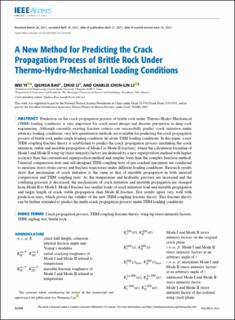| dc.contributor.author | Yi, W. | |
| dc.contributor.author | Rao, Qiuhua | |
| dc.contributor.author | Li, Z. | |
| dc.contributor.author | Li, Charlie Chunlin | |
| dc.date.accessioned | 2021-10-26T09:12:48Z | |
| dc.date.available | 2021-10-26T09:12:48Z | |
| dc.date.created | 2021-06-17T14:56:41Z | |
| dc.date.issued | 2021 | |
| dc.identifier.citation | IEEE Access. 2021, 9 82888-82902. | en_US |
| dc.identifier.issn | 2169-3536 | |
| dc.identifier.uri | https://hdl.handle.net/11250/2825598 | |
| dc.description.abstract | Prediction on the crack propagation process of brittle rock under Thermo-Hydro-Mechanical (THM) loading conditions is very important for crack-arrest design and disaster prevention in deep rock engineering. Although currently existing fracture criteria can successfully predict crack initiation under arbitrary loading conditions, very few quantitative methods are available for predicting the crack propagation process of brittle rock under single loading condition, let alone THM loading conditions. In this paper, a new THM coupling fracture theory is established to predict the crack propagation process (including the crack initiation, stable and unstable propagation of Mode I or Mode II fracture), where the calculation formulae of Mode I and Mode II wing-tip stress intensity factors are deduced by a new superposition method with higher accuracy than the conventional superposition method and simpler form than the complex function method. Uniaxial compression tests and self-designed THM coupling tests of pre-cracked specimens are conducted to measure stress-strain curves and fracture trajectories under different loading conditions. Research results show that mechanism of crack initiation is the same as that of unstable propagation in both uniaxial compression and THM coupling tests. As the temperature and hydraulic pressure are increased and the confining pressure is decreased, the mechanisms of crack initiation and unstable propagation are changed from Mode II to Mode I. Mode I fracture has smaller loads of crack initiation load and unstable propagation and larger length of crack stable propagation than Mode II fracture. Test results agree very well with prediction ones, which proves the validity of the new THM coupling fracture theory. This fracture theory can be further extended to predict the multi-crack propagation process under THM loading conditions. | en_US |
| dc.language.iso | eng | en_US |
| dc.publisher | Institute of Electrical and Electronics Engineers (IEEE) | en_US |
| dc.rights | Navngivelse 4.0 Internasjonal | * |
| dc.rights.uri | http://creativecommons.org/licenses/by/4.0/deed.no | * |
| dc.title | A New Method for Predicting the Crack Propagation Process of Brittle Rock under Thermo-Hydro-Mechanical Loading Conditions | en_US |
| dc.type | Peer reviewed | en_US |
| dc.type | Journal article | en_US |
| dc.description.version | publishedVersion | en_US |
| dc.source.pagenumber | 82888-82902 | en_US |
| dc.source.volume | 9 | en_US |
| dc.source.journal | IEEE Access | en_US |
| dc.identifier.doi | 10.1109/ACCESS.2021.3076001 | |
| dc.identifier.cristin | 1916464 | |
| cristin.ispublished | true | |
| cristin.fulltext | original | |
| cristin.qualitycode | 1 | |

